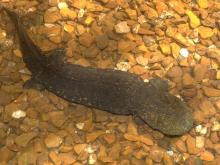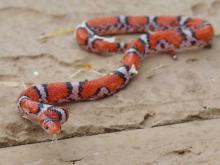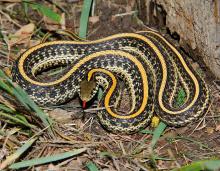Reptiles and Amphibians
Media

Species Types
Scientific Name
Thamnophis proximus proximus
Description
The orange-striped ribbonsnake is a type of gartersnake named for the attractive orange or yellow stripes running the length of its body, alternating with wide black stripes. It is found statewide, but seldom far from water.
Media

Species Types
Scientific Name
Necturus maculosus maculosus
Description
Mudpuppies are aquatic salamanders that have plumelike external gills throughout their entire lives. They’re found in the southern half and along the eastern edge of Missouri.
Media

Species Types
Scientific Name
Cryptobranchus alleganiensis alleganiensis
Description
The eastern hellbender is a large, entirely aquatic salamander with a wide, flat head, small, lidless eyes, and soft folds of skin on the sides. In Missouri, it occurs in the northern Ozark highlands in spring-fed rivers that drain north into the Missouri and Meramec river drainages.
Media

Species Types
Scientific Name
Cemophora coccinea copei
Description
One of Missouri's most brilliantly colored snakes is also extremely rare to find. The northern scarletsnake is similar in pattern and color to the more common red milksnake but has a red or orange snout and a spotless, white belly.
Media

Species Types
Scientific Name
Lampropeltis triangulum
Description
The harmless eastern milksnake is white, yellow, or light tan, with red or orange blotches bordered with black. The belly is white and strongly checked with black. This species often is misidentified as the venomous coralsnake, which is not found in Missouri.
Media

Species Types
Scientific Name
Terrapene carolina triunguis
Description
The three-toed box turtle usually has three hind toes. Its high-domed shell usually has a top ridge and is olive or brown with faint yellow or orange lines. Look for it in woodland habitats.
Media

Species Types
Scientific Name
Chrysemys picta bellii
Description
The western painted turtle is a small, brightly colored aquatic turtle. The upper shell is smooth and has a red-orange outer edge. The colorful lower shell has a prominent pattern of brown markings. It is found nearly everywhere in the state except the southeast region.
Media

Species Types
Scientific Name
Thamnophis sirtalis sirtalis (eastern gartersnake) and T. s. parietalis (red-sided gartersnake)
Description
The eastern gartersnake and red-sided gartersnake are Missouri's most common gartersnakes. The color is variable, but there are normally three yellowish stripes, one down the back and one on each side. There are narrow black bars between the scales along the upper lip.
Media

Species Types
Scientific Name
Storeria occipitomaculata
Description
The red-bellied snake is one of Missouri's smallest snakes. It is gray or reddish brown on top, usually with narrow stripes, and bright red or orange below. It occurs nearly statewide but appears to be absent from the northwest and southwest corners.
Media

Species Types
Scientific Name
Thamnophis radix
Description
A medium-sized, striped snake of wet prairies and marshes, the plains gartersnake occurs mainly in Missouri's north-central and northwestern counties, with isolated populations in and west of the St. Louis area.
See Also
About Reptiles and Amphibians in Missouri
Missouri’s herptiles comprise 43 amphibians and 75 reptiles. Amphibians, including salamanders, toads, and frogs, are vertebrate animals that spend at least part of their life cycle in water. They usually have moist skin, lack scales or claws, and are ectothermal (cold-blooded), so they do not produce their own body heat the way birds and mammals do. Reptiles, including turtles, lizards, and snakes, are also vertebrates, and most are ectothermal, but unlike amphibians, reptiles have dry skin with scales, the ones with legs have claws, and they do not have to live part of their lives in water.





















